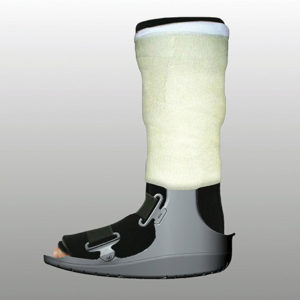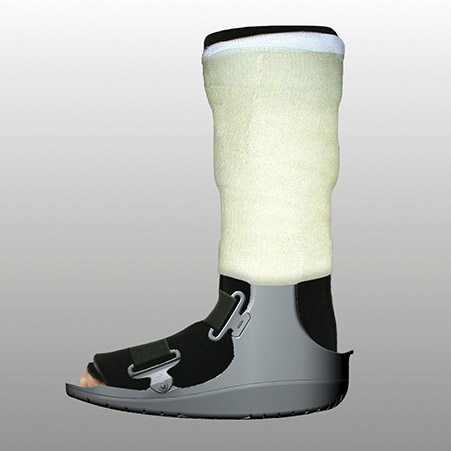
This example of an instant total contact cast is not the exact model used in the balance study. (Photo courtesy of David Armstrong, DPM, MD, PhD.)
By Emily Delzell
Instant total contact casts (iTCCs), which add length and weight to the involved leg, perturb balance in healthy individuals and could increase fall risks in the already–balanced challenged population of individuals with diabetic peripheral neuropathy.
In a study presented last month at the American Physical Therapy Association’s 2013 Combined Sections Meeting in San Diego, researchers tested static and dynamic balance in 12 healthy adults under three conditions: no iTCC; an iTCC paired with a heel lift for the uninvolved leg; and an iTCC alone. Investigators used an iTCC with a rocker bottom, double uprights, and a Velcro closure. The heel-lift height, designed to lift the pelvis and correct leg-length discrepancies introduced by the iTCC, varied according to the measured discrepancy.
Compared with the control condition, both of the iTCC conditions significantly decreased balance in quiet stance and during walking, said lead author Michelle Kunsman, PT, DPT, an assistant professor of physical therapy at American International College in Springville, MA.
Kunsman collaborated with Adam Goodworth, PhD, an assistant professor of rehabilitation sciences at the University of Hartford in Connecticut, on the study.
On all static and ambulatory tests, wearing the iTCC significantly increased sway measures and, in unperturbed walking, significantly reduced the percentage of power contained at the cadence frequency, suggesting walking was less rhythmic in the cast. In addition, functional reach for anterior-posterior movements was significantly decreased in individuals wearing the iTCC compared with the no-iTCC condition.
The only significant effects found with the heel-lift addition were in static tests, in which sway was significantly reduced compared with the iTCC alone.
“We have a couple different theories about why the heel lift worked more in static situations as opposed to dynamic,” Kunsman told LER. “First, in the dynamic situations, there was no time when the heel lift made balance worse, and we felt this was a positive finding; in addition, oftentimes the patients said they felt more comfortable having the leg-length discrepancy corrected [during dynamic testing], so we saw an effect, but it wasn’t statistically significant.”
Kunsman noted the study sample was small and that the heel lifts lacked the customization that might have provided greater stability.
“We fabricated the heel lifts, but, other than correcting individual leg-length discrepancies, didn’t customize them for each person, and some people said they felt the lift had too steep a drop-off,” she said. “We think this may be why we saw better results in quiet stance because, when they were walking, the drop-off made the heel lift uncomfortable.”
Kunsman and Goodman intend to address this issue in their upcoming follow-up study, which will involve individuals with diabetes and a loss of protective sensation in their feet.
“We may work with an orthotist to custom-make the inserts for individual patients, and we’re also going to make sure the drop-off is not as steep, so we’re going to bevel it a little better,” said Kunsman, who credits the University of Hartford for donating the lab space to make these investigations possible.
“We know balance is decreased with these devices and we’re concerned about fall risks and associated injuries,” she said. “We’re hoping to find a device that is clinically relevant, readily available, and inexpensive.”
David Armstrong, DPM, MD, PhD, an advocate of iTCCs and professor of surgery and director of the Southern Arizona Limb Salvage Alliance (SALSA) at the University of Arizona College of Medicine in Tucson, reviewed the abstract for LER. He noted his clinical experience has involved postural issues associated with offloading devices.
“We have found that many different kinds of devices to offload the foot, including the total contact cast and the instant total contact cast, can make people more unsteady,” he said. “However, we’ve also noticed the opposite effect in some patients. In fact, some have shown paradoxical reliance on the increased rigidity and stability of a cast or a brace to, in effect, ‘limp’ on the rigid leg.”
He noted that his team at SALSA and its interdisciplinary Consortium on Advanced Motion Performance (iCAMP) is evaluating many different technologies in a similar manner to the CSM study.
“I think that this study should highlight the importance of instability and vigilance toward fall prevention,” he said.
Source:
Kunsman M, Goodworth AD. Influence of instant total contact casts on balance. Presented at the American Physical Therapy Association Combined Sections Meeting; San Diego, CA; January 2013.









